A Guide to German Christmas Traditions
Willkommen! From advent calendars to Christmas markets, get ready to explore the festive customs and rituals that make German Christmas celebrations truly magical. So put on your favorite Christmas sweater, grab a cup of Glühwein, and let’s get started!
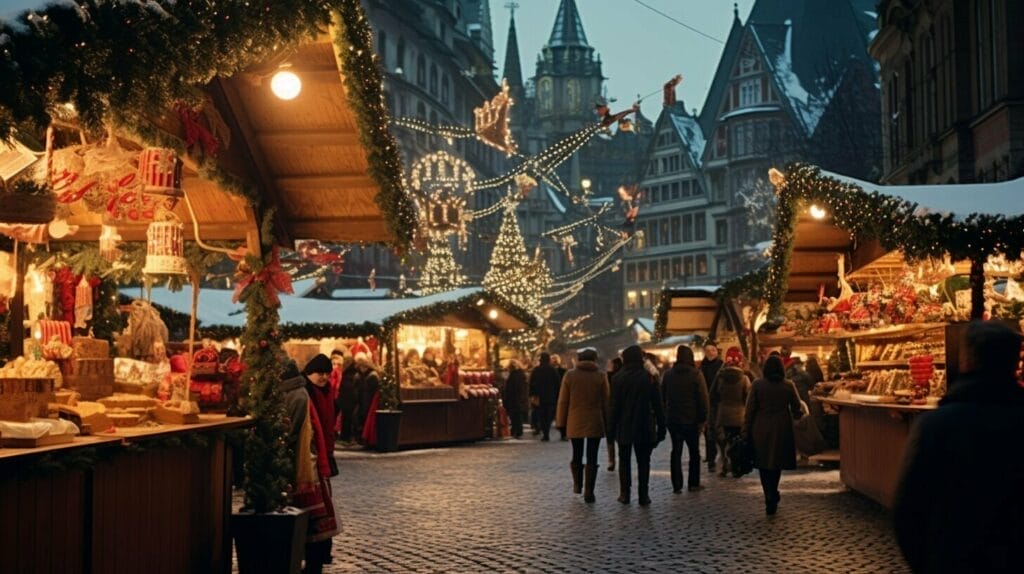
Quick Summary
- German Christmas traditions are full of enchanting customs and rituals that come alive during the holiday season.
- Christmas markets, advent calendars, Stollen, and Lebkuchen are just a few of the many festive traditions that are unique to Germany.
- The Tannenbaum, or Christmas tree, is an integral part of German Christmas celebrations and plays a significant role in decorating homes.
- German Christmas traditions have both a dark and light side, including Krampus, the companion of Saint Nicholas, and the gift-giving traditions associated with Christmas Eve.
- Europe as a whole is rich in festive customs, but German Christmas traditions hold a special place in the hearts of many.
The Advent Calendar and the Count Down to Christmas
Ah, the advent calendar. What better way to count down the days until the most magical holiday of the year? German Christmas traditions wouldn’t be complete without this beloved tradition. You probably remember getting one as a kid; opening the little doors each day to reveal a treat or small gift inside. And let’s be real, even as an adult, you still secretly crave the excitement of each new day’s surprise.
But where did this tradition come from? It’s said that the first advent calendar was created in Germany in the 19th century, to help children count down the days until Christmas. Originally, the advent calendar consisted of simple illustrations behind each door, but over the years it has evolved to include chocolate, toys, and even beauty products.
Today, you can find advent calendars in all shapes and sizes, from the classic cardboard design to more extravagant versions like this Beer Advent Calendar (yes, you read that right). No matter what style you choose, the advent calendar is the perfect way to bring some festive excitement to your daily routine and keep the anticipation building until Christmas day.
German Christmas Markets
Germany is home to some of the most enchanting Christmas markets in the world, and the Christkind, an angelic figure, is at the heart of it all. Take a stroll through the festive stalls at the Weihnachtsmarkt, or Christmas market, and you’ll see the Christkind’s influence everywhere.

With its shimmering lights, delicious treats, and unique crafts, the Christmas market is a feast for the senses. The Christkind, often portrayed as a young girl with golden hair and wings, is believed to bring gifts to children on Christmas Eve. At the Christmas market, you can even catch a glimpse of the Christkind herself, dressed in a flowing white gown and a golden crown as she presides over the festivities.
As you peruse the market, you’ll discover a treasure trove of traditional German Christmas items, such as hand-carved nutcrackers, delicate glass ornaments, and the beloved Lebkuchen, a spicy gingerbread treat. Don’t forget to grab a warm cup of Glühwein, a mulled wine, to chase away the winter chill.
With its magical atmosphere and time-honored traditions, the German Christmas market is the perfect place to immerse yourself in the spirit of the holiday season. So come experience the wonder of the Christkind and all the joys of the Weihnachtsmarkt.
The Sweet Side of German Christmas: Stollen and Lebkuchen
When it comes to German Christmas traditions, it’s impossible to ignore the aroma of freshly baked Stollen and Lebkuchen. These delectable treats are an essential part of the holiday season, and once you try them, you’ll understand why.
Stollen is a traditional Christmas bread made with candied fruit, nuts, and spices, and often dusted with powdered sugar. It’s believed to have originated in Dresden, Germany, and has since become a beloved holiday staple throughout the country.

Lebkuchen, on the other hand, is a type of gingerbread that has been a part of German Christmas traditions for centuries. It’s made with honey, molasses, and a blend of spices like cinnamon, cloves, and nutmeg. Lebkuchen comes in many variations, from soft and chewy to hard and crunchy.
Both Stollen and Lebkuchen are delicious on their own, but they’re often enjoyed with a cup of hot Glühwein (mulled wine) at Christmas markets or as a dessert after a festive meal with family and friends.
But the history and tradition behind these sweet treats is just as interesting as their flavor. Stollen has been traced back to the 1400s, when it was baked as a special Christmas treat by the Prince of Saxony. And Lebkuchen has a long and storied history, with some records indicating it was already a staple of German Christmas traditions in the 1300s.
So, when you take a bite of Stollen or Lebkuchen this holiday season, you’re not just savoring a delicious treat—you’re also experiencing centuries of German Christmas tradition and culture.
The Tannenbaum and the Tradition of Christmas Trees
Ah, the Tannenbaum, or as you may know it, the Christmas tree… but in Germany, it’s so much more than just a tree. It’s a centerpiece of German Christmas traditions and has been for centuries.
The tradition of decorating a tree dates back to the 16th century, where devout Christians brought trees into their homes and decorated them with apples, nuts, and candles to commemorate Adam and Eve’s day of repentance. But it wasn’t until the 19th century that the Tannenbaum became the common symbol of Christmas in Germany.
Nowadays, the Tannenbaum is the heart and soul of German Christmas decorations. They are usually purchased a few days before Christmas and decorated on Christmas Eve. You’ll see them in every town square and almost every German household.
The Tannenbaum is traditionally decorated with handmade ornaments, candles, and tinsel. These days, it’s not uncommon to see a Tannenbaum adorned with modern decorations like LED lights and baubles, but the handmade decorations are still highly valued.
But it’s not just the decorations that make the Tannenbaum special, it’s also the tradition of gathering around it with family and friends. It’s the feeling of warmth and togetherness that the Tannenbaum represents that makes German Christmas traditions so beloved.

So, go ahead and take part in this beloved German Christmas tradition. Get yourself a Tannenbaum, decorate it with ornaments, tinsel, and lights, and bask in the warm glow of its lights with your loved ones this holiday season. Frohe Weihnachten!
The Warmth of German Christmas Drinks: Glühwein and Feuerzangenbowle
When the frost is nipping at your nose and the chill is settling into your bones, warm up your holiday spirit with traditional German Christmas drinks. You’ll find yourself drawn to the rich, luscious flavors of Glühwein and Feuerzangenbowle, two quintessential beverages of the Weihnachtszeit (Christmas time).
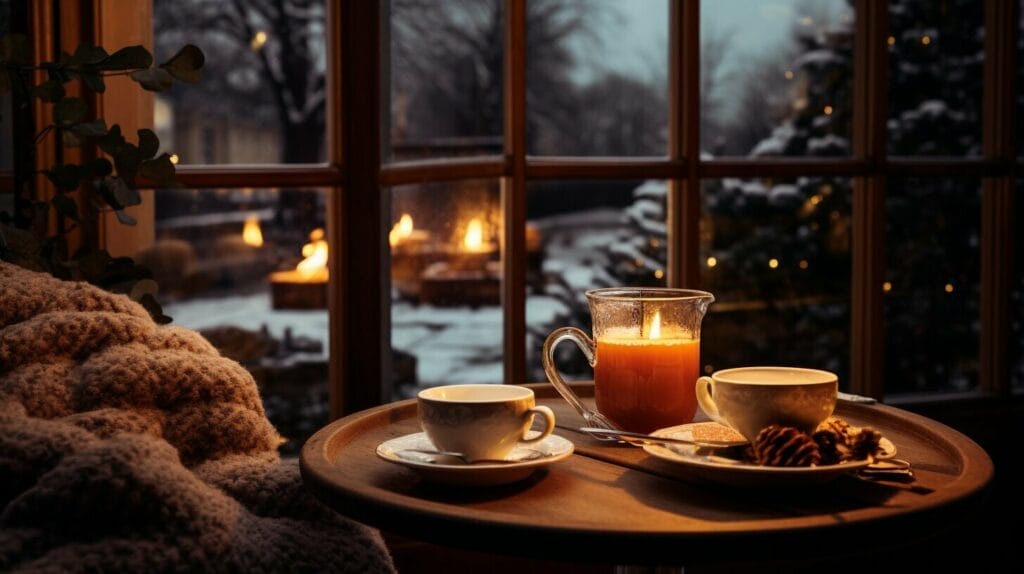
Let’s start with Glühwein, a hot, spiced, and sweet red wine that is a staple during Christmas markets. The name “Glühwein” translates to “glowing wine,” which is fitting as it’s served hot and will warm you from the inside out. It is made with a variety of spices such as cloves, cinnamon, and vanilla, and sometimes with a dash of rum or brandy. You can enjoy Glühwein while strolling through Christmas markets, visiting friends and family, or better yet, snuggled up at home near the fireplace.
If you’re looking for something a little more dramatic, look no further than Feuerzangenbowle, a fiery and theatrical punch that is sure to impress. This beverage is made by soaking a sugarloaf with rum, placing it atop a metal grate above a pot of mulled wine, and lighting it on fire. As the sugar melts, it drips into the wine, creating a deliciously caramelized flavor. It’s a show-stopping spectacle that is perfect for entertaining guests.
So, whether you prefer the traditional, comforting flavors of Glühwein or the dramatic flair of Feuerzangenbowle, these German Christmas drinks are sure to warm your spirit and bring cheer to your holiday season. Cheers! Or as the Germans would say, Prost!
The Dark and Light Sides of Gift-Giving: Krampus and Nikolaus
Gift-giving during the holiday season is a long-standing tradition in German Christmas celebrations. But did you know that there are both dark and light sides to this custom?
On the light side, there is the beloved Saint Nicholas, or Nikolaus, who delivers presents to the well-behaved children. He is often depicted as a kindly old man with a white beard and a red suit. Sound familiar?
Yes, that’s right. The modern-day Santa Claus, or Weihnachtsmann, is actually based on the German tradition of Nikolaus. And although he is no longer commonly referred to as Saint Nicholas, his roots are deeply embedded in German Christmas customs.
But on the dark side, there is Krampus. This horned, devil-like creature is the companion of Saint Nicholas and punishes children who misbehave, sometimes even taking them away in a sack. Yikes!
But don’t worry, you’re probably not going to encounter Krampus during your German Christmas festivities (unless you happen to stumble upon a Krampuslauf, or Krampus run, that is). But it’s always good to be on your best behavior, just in case.
Now, back to the light side of gift-giving. In Germany, presents are typically exchanged on Christmas Eve, or Heiligabend, during a tradition called Bescherung. This can take place either before or after attending church services, and often involves the entire family gathering together to open gifts.
So, whether you’re on the light side with Nikolaus or the dark side with Krampus, gift-giving is a cherished tradition during German Christmas celebrations. Just remember to be good for goodness’ sake (and maybe leave out some extra cookies for Santa and his companions).
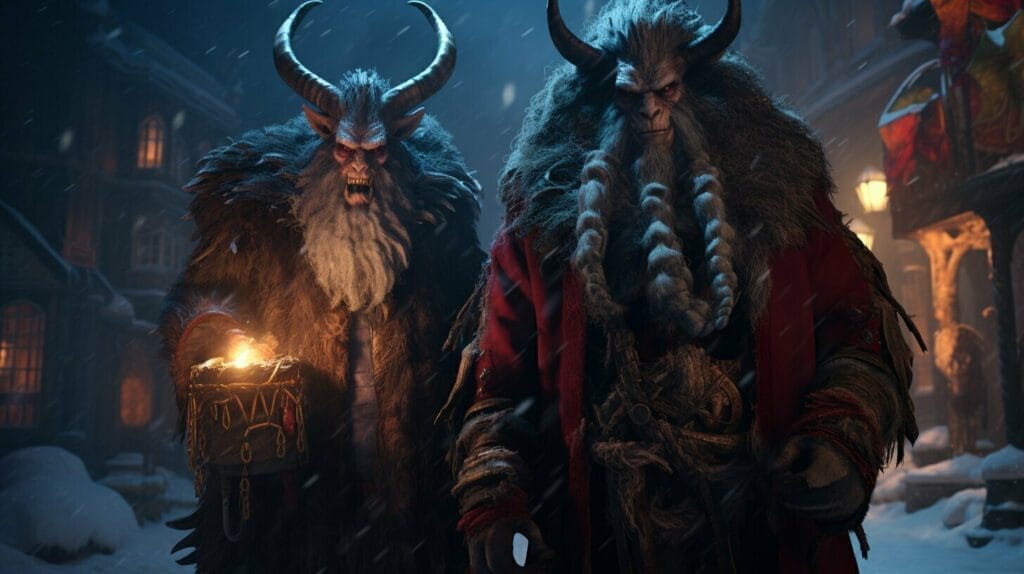
It’s hard to imagine the Christmas season without the sweet sound of carols. Weihnachtslieder, or Christmas carols, are an integral part of German Christmas traditions. From the classics like “Stille Nacht” (Silent Night) to newer pop versions, you’ll hear these beloved songs everywhere you go.
And what better setting to hear these carols than in the midst of a Weihnachtskrippe, or nativity scene? These elaborate displays featuring the holy family, animals, and the three wise men, are a staple in German homes during the holiday season. It’s a beautiful reminder of the reason for the season, amidst all the fun and festivities.
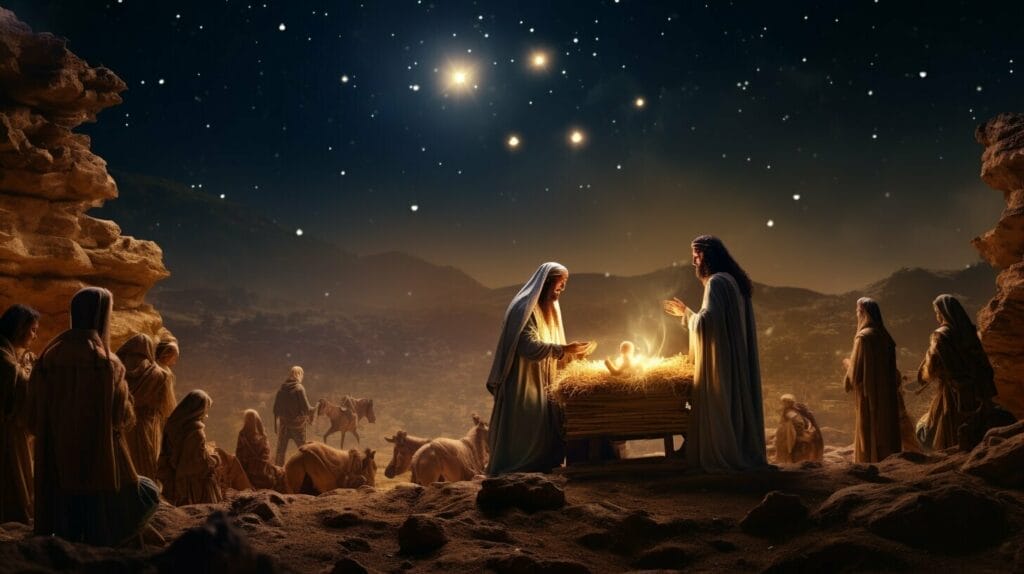
So gather around the nativity scene, let the carols fill the air, and allow the magic of German Christmas traditions transport you to a world of wonder and joy.
Celebrating Christmas Eve in Germany: Heiligabend and Weihnachtsgans
Ah, Christmas Eve in Germany, a magical night you won’t soon forget. The festivities kick off with Heiligabend, a time when friends and family gather together to celebrate the season in true German fashion. And what better way to celebrate than with a delicious Weihnachtsgans, or Christmas goose?
As you sit down to your sumptuous feast, take a moment to appreciate the significance of the meal. The Christmas goose has been a staple of German Christmas celebrations for centuries, symbolizing abundance, prosperity, and good fortune. And let’s be real, it’s also pretty darn tasty.
Traditionally, the goose is served with red cabbage and Klöße, or potato dumplings, making for a truly decadent meal. Don’t forget to pair it with a glass of Glühwein (mulled wine) or Feuerzangenbowle (a fiery punch), and toast to the joys of the season.

After dinner, it’s time for Bescherung, or gift-giving. As the clock strikes midnight, family members exchange presents and revel in the festive spirit. It’s a time of joy, love, and togetherness.
So if you find yourself in Germany during the holiday season, make sure to experience the magic of Heiligabend and indulge in a delicious Weihnachtsgans. You won’t regret it.
Unique German Customs: Sternsinger, Räuchermännchen, and More
German Christmas traditions are not just about food and drink. They also involve some unique and quirky customs that add to the festive spirit. We’re talking about the Sternsinger, Räuchermännchen, and the celebration of the Three Wise Men, known as Heilige Drei Könige.
Let’s start with the Sternsinger, also known as the star singers. This tradition involves children dressing up as the Three Wise Men and visiting households to sing carols, offer blessings, and collect donations for charity. It’s a heartwarming tradition that brings joy to both the children and the recipients of their goodwill.
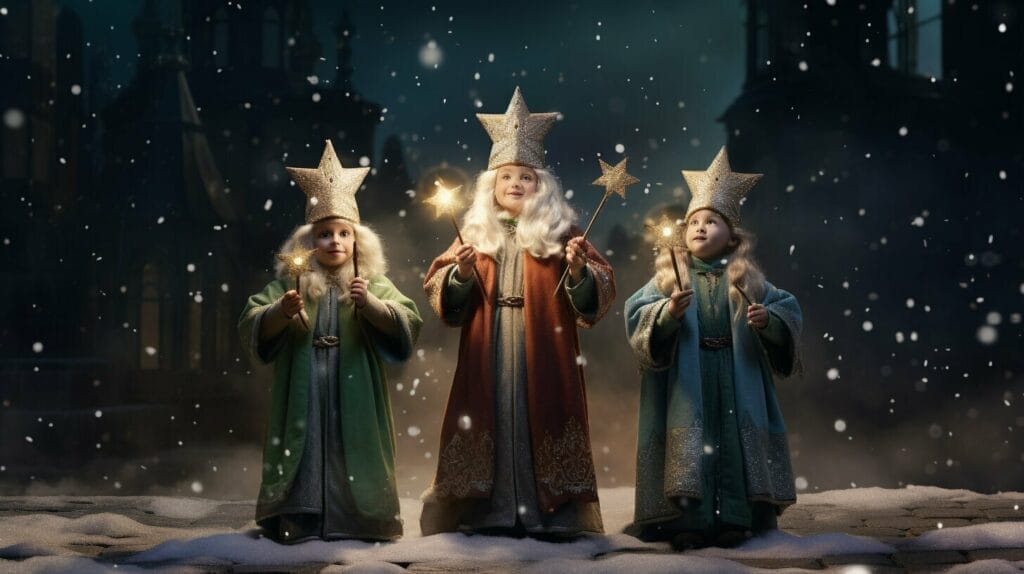
Another fascinating tradition is that of the Räuchermännchen, or smoking man. These are wooden figurines of craftsmen, miners, and other characters who appear to be smoking a pipe. They are placed on a tray with burning incense inside so that the smoke emanating from the pipe creates a festive aroma in the house.
Finally, there’s the celebration of the Three Wise Men, known as Heilige Drei Könige. On this day, children dress up as the wise men, visit homes, and recite poems or sing carols, while collecting donations for charity. It’s a fun and heartwarming tradition that brings together families and communities.
These unique German customs are a testament to the country’s rich cultural heritage and its love for all things festive. So, why not try incorporating them into your own holiday celebrations this year?
Baking Christmas Delights: Weihnachtsplätzchen and Weihnachtsstollen
What’s better than the aroma of freshly baked Christmas cookies wafting through your home during the festive season? Nothing, that’s what. And when it comes to German Christmas traditions, Weihnachtsplätzchen (Christmas cookies) are a must-have. These delectable treats come in a variety of shapes, sizes, and flavors, and are often decorated with colorful icing or sprinkles. From traditional Lebkuchen to buttery Vanillekipferl, the options are endless.
But the indulgences don’t stop there. Weihnachtsstollen, a Christmas loaf made with fruit and marzipan, is another beloved treat during the holidays. Served with a cup of warm Glühwein, it’s the perfect way to cozy up during the colder months.
Of course, no German Christmas celebration is complete without the Adventskranz (Advent wreath), a wreath made of evergreen branches and four candles, one for each Sunday leading up to Christmas. As each candle is lit, it signifies the progression of the Advent season and the approach of the special day. It’s the perfect decoration for your holiday table as you enjoy your Weihnachtsplätzchen and Weihnachtsstollen.

So dust off your apron, preheat your oven, and get ready to indulge in these mouthwatering German Christmas treats. Whether you opt for traditional recipes or put your own spin on things, you can’t go wrong with Weihnachtsplätzchen and Weihnachtsstollen. And don’t forget the Adventskranz to complete the festive mood.
Germany offers some of the most enchanting Christmas traditions in Europe. If you get a chance to spend Christmas in a German city, take advantages of the Christmas signts, sounds, markets and events that take place.
FAQ
What are some popular German Christmas traditions?
German Christmas traditions include advent calendars, Christmas markets, decorating Christmas trees (Tannenbaum), baking traditional treats like Stollen and Lebkuchen, and celebrating Christmas Eve (Heiligabend) with a festive feast.
What is the significance of the advent calendar in German Christmas traditions?
The advent calendar is used to count down the days until Christmas. Each day, a door or pocket is opened to reveal a small gift or treat, building excitement and anticipation for the holiday.
Who is the Christkind and what role does it play in German Christmas traditions?
The Christkind is an angelic figure who brings gifts to children on Christmas Eve. It is often depicted as a young girl with angelic wings, symbolizing the spirit of the holiday season.
What can I expect to find at a German Christmas market?
German Christmas markets are known for their festive atmosphere and offer a wide variety of goods, including unique crafts, delicious food and drinks, and traditional holiday decorations.
What are Stollen and Lebkuchen?
Stollen is a traditional German fruitcake made with dried fruit, nuts, and spices, often dusted with powdered sugar. Lebkuchen are gingerbread-like cookies typically flavored with honey, spices, and nuts.
Why is the Tannenbaum (Christmas tree) important in German Christmas traditions?
The Tannenbaum is a symbol of hope, life, and light during the dark winter months. Decorating the Christmas tree is a cherished tradition, with ornaments, lights, and sometimes even real candles.
What are Glühwein and Feuerzangenbowle?
Glühwein is a warm mulled wine often served at German Christmas markets. Feuerzangenbowle is a hot punch made by setting a sugarloaf soaked in rum on fire and allowing it to drip into the wine.
Who is Krampus and how does it relate to German Christmas traditions?
Krampus is a mythical creature in German folklore who accompanies Saint Nicholas. While Saint Nicholas brings gifts to good children, Krampus punishes the naughty ones, serving as a reminder of both the light and dark sides of the holiday season.
What are Weihnachtslieder and Weihnachtskrippe?
Weihnachtslieder are Christmas carols that are sung during the holiday season in Germany. Weihnachtskrippe refers to elaborate nativity scenes that depict the birth of Jesus, often including figurines of Mary, Joseph, Baby Jesus, and the Three Wise Men.
How is Christmas Eve (Heiligabend) celebrated in Germany?
Christmas Eve in Germany is a time for family gatherings and a festive feast. Traditional dishes like Weihnachtsgans (Christmas goose) are often enjoyed, along with the exchange of gifts.
What are some unique German Christmas customs?
Some unique German Christmas customs include Sternsinger (star singers), where children dress up as the Three Wise Men and go door to door singing and collecting donations, and Räuchermännchen, which are small wooden figurines that release fragrant incense when their bellies are filled with smoking incense cones.
What are Weihnachtsplätzchen and Weihnachtsstollen?
Weihnachtsplätzchen are Christmas cookies that come in various shapes and flavors, often decorated with icing or sprinkles. Weihnachtsstollen is a rich loaf-shaped cake filled with dried fruit, nuts, and marzipan, typically dusted with powdered sugar.
Are German Christmas traditions unique to Germany?
While German Christmas traditions have their own unique elements, many other European countries also have their own festive customs that differ slightly. Christmas traditions vary across different regions and cultures.




